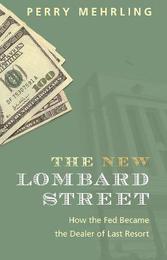
|
The New Lombard Street: How the Fed Became the Dealer of Last Resort
Paperback / softback
Main Details
| Title |
The New Lombard Street: How the Fed Became the Dealer of Last Resort
|
| Authors and Contributors |
By (author) Perry Mehrling
|
| Physical Properties |
| Format:Paperback / softback | | Pages:192 | | Dimensions(mm): Height 216,Width 140 |
|
| Category/Genre | Economic history
Banking |
|---|
| ISBN/Barcode |
9780691242200
|
| Classifications | Dewey:332.110973 |
|---|
| Audience | | Tertiary Education (US: College) | | Professional & Vocational | |
|---|
|
Publishing Details |
| Publisher |
Princeton University Press
|
| Imprint |
Princeton University Press
|
| Publication Date |
29 November 2022 |
| Publication Country |
United States
|
Description
Presents the innovative principles needed to address the instability of the markets and to rebuild our financial system. This book traces the evolution of ideas and institutions in the American banking system since the establishment of the Federal Reserve in 1913. It explains how the Fed took classic central banking wisdom from Britain and Europe.
Author Biography
Perry Mehrling is professor of economics at Barnard College, Columbia University. He is the author of Fischer Black and the Revolutionary Idea of Finance and The Money Interest and the Public Interest: American Monetary Thought, 1920-1970.
Reviews"A well-written, scholarly dissection that should be required reading for all graduate courses (and perhaps some advanced undergraduate) in macroeconomics or monetary economics." * Choice * "With lucid precision, Mehrling traces the history of how Fed policy makers became biased toward 'excessive elasticity'. . . . Mehrling saves the best for the end, where he describes the Fed's battle to save the system with an alphabet soup of lending programs."---James Pressley, Bloomberg News "An important book about the new Fed."---Tyler Cowen, Marginal Revolution "In The New Lombard Street, Perry Mehrling . . . provides a lucid account of how the system worked when it was working-and of the growing role assumed by the Fed in an era of global economic volatility and 'credit-fueled bubbles.'"---Glenn C. Altschuler, Tulsa World "[A] fantastic book."---Rortybomb, Mike Konczal blog "Important. . . . Mehrling's new book tries to do just what Bagehot did: to give an account both of how and why the Fed acted when it reinvented the rules in the middle of a financial crisis, and of what the implications for future monetary policy will be."---Harold James, Central Banking Journal "This is an excellent and accessible analysis for anyone wishing to understand the origins of the financial crisis and how the Fed came to respond as it did."---Larry Hatheway, Business Economist "The book can be read as an important contribution in the ongoing debate on the future of central banks. In terms of monetary policy thinking, this book is another contribution to the increasing awareness that central banks, perhaps lured by seeming success of inflation targeting, in the years before 2008 did not manage to strike the right balance between monetary and financial stability."---Lars Fredrik Oksendal, Enterprise & Society
|